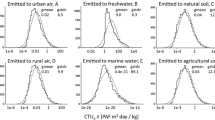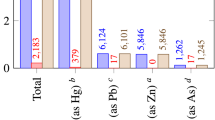Abstract
This paper describes the experience with impact assessment of toxic releases in a Substance Flow Analysis (SFA) for PVC in Sweden. For this system, all emissions related to the PVC-chain were inventoried. They have been evaluated making use of the Life Cycle Impact Assessment (LCIA) step from the CMI.-guide, including the new toxicity equivalency factors calculated with the Uniform System for Evaluation of Substances (USES). The application of this method led to the conclusion that I.CA Impact Assessment of toxic releases is still a major bottleneck: the USES-equivalency factors are not to he trusted due to outdated data, inappropriate defaults, etc. in the USES’ substance properties database. Therefore, a second USES-ser of factors was calculated that differed up to factors of 1,000 or more from the old ones. Even these factors probably suffer from unacceptable high structural, in practice not reducible uncertainties. In conclusion, we warn the LCA community not to overestimate the possibility of LCA Impact Assessment to obtain a meaningfull priority setting with regard to toxicity problems. Instead, we propose develo** indicator systems for LCIA of toxic releases that genuinely deal with all relevant types of uncertainty: data uncertainty, modelling uncertainty and particularly paradigmatic uncertainty.
Similar content being viewed by others
References
Amsterdamska, O. andR. Hacendijk (1990): De nieuwe zekerheden van het hedendaagse wetenschapsonderzoek [The new certainties of present day’s research of science]. Kennis en methode 1990/1
Berg, N.V.D. et al. (1995): Beginning LCA. Unilever and CML, Leiden, Holland
Bowden, G. (1985): The Social Construction of Validity in Estimates of US Crude Oil Reserves. Social Studies of Science, Vol.15,207–40
Braunschweig, A., R. Forster, P. Hofstetter R. Mueller-Wenck (1996): Developments in LCA valuation. IWO Diskussions- papier Nr. 32, St. Gallen, Switzerland
CML (1996): Letter concerning default data in USES to the readers of Guinée et al. (1996a). CML, Leiden, 1996
Consou, F. D. Allen, I. Boustead, J. Fava, W. Franklin, A.A. Jensen, N. De Oude, R. Parrish, R. Perriman, D. Postlewaite, B. Quay, J. Seguin andB. Vicon (1993): Guidelines for Life-Cycle Assessment: A Code of Practice. SETAC, Brussels, Belgium
Colborn, T., D. Dumanoski andJ.P. Mayers (1996): Our stolen future: are we threatening our fertility, intelligence and survival. Penguin Books Inc. USA
Copius Peerkboom, J.W. (1996): A disputable chlorine balance. (in Dutch), Milieu 1996/5, Boom Publishers, Meppel, The Netherlands
Cowan, C.E., D. Mackay, T.C.J. Fkitkl, D.V.d. Mefnt, A. Di Guardo,J.Davies N. Mackay (1995): The Multimedia Fate Model: A vital tool for prediction of the fate of chemicals.SETAC Press, Pensacola, Florida, USA
Cranor, C.F. (1993): Regulating toxic substances. A philosophy of science and the law. Oxford university press, New York, USA
DOSE (undated, continuous updates), The Dictionary of Substances and their effects. CD-ROM, The Royal Society of Chemistry, Cambridge, UK
Douglas, M. andA. Wildavsky (1982): Risk and Culture. University of California Press, Berkeley, USA
EDF (Environmental Defense Fund) (1997): Toxic Ignorance. EDF, Washington D.C., USA (also available at: www.edf.org)
Funtowicz, S.O. andJ.R. Ravetz (1990): Uncertainty and quality in science for policy. Theory and Decision Library, ser. A, Vol. 15, Kluwer, Dordrecht, Holland
Finnveden, G. L-G. Lindfors, andL. Wennberg (1996): Alternativa material till PVC. IVL Rapport B 1232, IVL, Stockholm, Sweden
Finnveden, G. andL-G. Lindfors (1997): Life cycle impact assessment and interpretation. In: Udo de Haes and Wrisberg (1997)
Finnveden, G. (1997): Letter to the editor. Int. J. LCA 2 (4) 185
Gunther, A. andH-C. Langowski (1997): Life Cycle Assessment Study on Resilient Floor Coverings. Int. J. LCA 2(2) 73–80
Gunther, A. andH-C. Langowski (1997): Life Cycle AssessmentStudy on Resilient Floor Coverings. Int. J. LCA 2(2) 73–80
GuinÉe, J. B., R. Heijungs, L.van Oers, D.V.D. Meent, T. Vermeire andM. Rikken (1996a): LCA Impact assessment of toxic releases.CML/RIVM, Product policy series 1996/21, Ministryfor the Environment, The Hague, Holland
GuinÉ, J.B.R. Heijungs, L. vanOers, D.V.D. Meent, T. Vermeire andM. Rikken (1996b): USES. Uniform System for the Evaluationof Substances. Inclusion of Fate in LCA Characterizationof Toxic Releases Applying USES 1.0. Int. J. LCA 1 (3)133–138
Heijungs, R., J.B. GuinÉ, G. Huppes, R.M. Lankreijkr, H.A. Udo de Haes, A. Wegener Sleeswijk, A.A.M. Ansems, P.G. Egcels, R. van Duin andH.P. de Goedf. (1992): Environmental Lifecycle Assessment of Products, Guide and backgrounds. CML/TNO/B&G, Leiden, Holland
Heijungs, R. (1996): Identification of key issues for further investigationin improving the reliability of life-cycle assessments. J.Cleaner Prod. 4 (3/4) 159–166
Hofstetter, P. (forthcoming): Perspectives in Life Cycle ImpactAssessment: A structured approach to combine models of thetechnosphere, ecosphere and valuesphere (Provisional title).Ph.D. thesis, ETH Zurich, Switzerland, expected publicationdate: autumn 1998
Hunt, J. (1994): The social construction of precaution. In:O’Riordan, T. andJ. Cameron: Interpreting the precautionaryprinciple. Earthscan, London, UK
IJC (International Joint Commission) (1993): A strategy for virtualelimination of persistent toxic substances. Volume 1 and2, Report of the Virtual Elimination Task Force to the International Joint Commission, Windsor, Ontario, Canada
ISIS (undated), Internationaal Stoffen Systeem. Versie 5.1.HASKONING, Nijmegen, Holland
IUCLID (1996): International Uniform Chemical Information Database, Existing Chemicals. European Chemical Bureau, European Commission-JRC, Environment Institute, Ispra (Italy)
Jasanoff, S.S. (1987): Contested Boundaries in Policy-RelevantScience. Social Studies of Science, Vol. 17, 195–230
Jasanoff, S.S. (1990): The fifth branch: Science Advisors asPolicymakers. Harvard University Press, Cambridge, MA, USA
Jolliet, O. (1996): Impact assessment of human and eco-toxicityin life cycle assessment. In: Udo de Haes (1996)
Janus, J.A., J.M. Hesse, M.G.J. Rikken (eds.) (1994): Aandachtstoffenin het Nederlandse Milieubeleid overzicht 1994 [AttentionSubstances in the Dutch Environmental Policy - overview1994]. RIVM-report no. 601014006. Bilthoven, The Netherlands
KemI (1991): Risk reduction of chemicals. Report 1991/1, KemI,Solna, Sweden
KemI (1994): Phthalic Acid Esters Used as Plastic Additives. Report1994/12 KemI, Solna, Sweden
Kleijn, R.,A. Tukker andE.V.D. Voet (1997): Chlorine in theNetherlands, part I: An Overview. Journal for Industrial Ecologynr. 1: 1
KlGuinöpifer, W. (1996): Reductionism versus Expansionism in LCA.Int. J. LCA 1 (2) 61
Koeman, J.H.,H.A.J. Covers,W.A. Hafkamp,A. van der Meidenand H.J.W. Sas (1995): Peer review Guin“Closing the chlorinechainGuin”. Apeldoorn, 17 and 18 August 1995, In: Tukker et al.(1995)
Knorr-Cetina, K. (1985): Germ Warfare, review of: B.Latour,Les Microbes: guerre et paix suivi de Irreductions. Social Studies of Science, Vol. 15, 577–85
Kuhn, T.S. (1962/1970): The structure of scientific revolutions.Dutch translation, Boom, Meppel, Holland
Latour, B. (1987): Science in action. Dutch translation 1995,Ooievaar Pockethouse, Amsterdam, Holland
Lkeuwfn, C.J. van (1995): General introduction. In:Leeuwen, C.J. van andJ.L.M. Hermens (eds.): Risk Assessment of Chemicals: An Introduction. Kluwer Academic Publishers, Dordrecht/Boston/London
Lindfors, L-G. (eds.) (1995): LCA-Nordic. Reports 1-9 and 10,TemaNord 1995:20, Nordic council of ministers, Copenhagen, Denmark
Lowenbach, W.A., R. Golden, E. Reese (1995): A model for estimatingBeef and Milk Bioconcentration Factors for DEHP. EnvironmentalRisk Sciences, Washington DC
McCray, L.E. (1983): An anatomy of risk assessment: scientificand extra scientific components in the assessment of scientific data on cancer risks. In National Academy of Sciences: RiskAssessment in the Federal Government: Managing the process. Working papers, National Academy press, Washington DC, USA
NCI (1995): Chloor op zijn plaats [Chlorine in the position itdeserves] and Risico’s van chloor beheersbaar [Risks of chlorinemanageable]. Journal of the Dutch Chemical Industry, 25 November 1995, Leidschendam, Holland
Owens, J.W. (1996): LCA Impact Assessment Categories. TechnicalFeasibility and Accuracy. Int. J. LCA 1 (3) 151–158
Pinch, T.J. (1981): The Sun-Set: The presentation of Certainty inScientific Life. Social Studies of Science, Vol.11, 131–58
Rip, A. (1986): Controversies as Informal Technology Assessment.Knowledge Vol. 8 No. 2, pp. 349–371
Rip, A. (1992): Risicocontroverses en de verwevenheid vanwetenschap en politiek [Controversies about Risks and the Linksbetween Science and Politics]. Kennis en Methode 1992/1
Rotmans, J., M.B.A. van Asselt, A.J. De Bruin, M.G.J, den Elzen, J. De Greef, H. Hilderink, A.Y. Hoekstra, M.A. Janssen, H.W. Koster, W.J.M. Martens, L.W. Niessen, de H.J.M. Vries (1994): Global change and sustainable development, a modelling perspectivefor the next decade. Report 461502004, RIVM, Bilthoven, The Netherlands
Rotmans, J. andH.J.M. de Vries (eds.) (1997): Perspectives onglobal futures: The TARGETS approach. Cambridge University Press, Cambridge
Shackley, S. andB. Wynne (1995): Mutual Construction — Globalclimate change: the mutual construction of an emergent science-policydomain. Science and Public Policy, Vol. 22, No. 4, pp. 218–230
Sluijs, J.V.D. (1997): Anchoring amid uncertainty. On the managementof uncertainties in risk assessment of anthropogenicclimate change. Ph.D. thesis, University of Utrecht, Utrecht, the Netherlands
Sluijs, J.V.D. andK. Schulte-Fishedick (1997): Omgaan metonzekerheden in wetenschap voor (milieu)beleid. Eeninventarisatie van theorieen en aanpakken [Dealing with uncertaintyin (environmental) policy. An inventory of theories andapproaches. Rathenau Instituut, The Hague, The Netherlands
Smithson, M. (1993): Ignorance and Science. Knowledge Vol. 15No. 2, 133–156
Staples C.A.,D.R. Peterson,T.F. Parkerton andW.J. Adams(1996): A literature review: The environmental fate of phthalateesters. Submitted to Chemosphere
Thompson, M. (1984): Among the Energy Tribes: A CulturalFramework for the Analysis and Design for Energy Policy. PolicySciences 17, pp. 321–339
Thompson, M., R. Ellis andA. Wildavsky (1990): Cultural theory.Westview press, Boulder, CO, USA
Tukker, A., R. Kleijn, E.V.D. Voet, M. Alkemade, J. Brouwer, H. de Groot, J. de Kontng, T. Pulles, E. Smeets andJ.J.D. van der Steen (1995):A chlorine balance for the Netherlands. Report95/40, TNO-STB and CML, Apeldoorn, Holland
Tukker, A., R. Kleijn, L. van Oers andE. Smeets (1996): A PVCsubstance flow analysis for Sweden. TNO and CML, report96/48, Apeldoorn, Holland
Tukker, A. andR. Kleijn (1996): Tentative LCA-normalisation datafor Sweden. TNO/CML, report 96/49, Apeldoorn, Holland
Tukker, A.,R. Kleijn,E v.d. Voet andE. Smeets (1997): Chlorinein the Netherlands Part II: Risk management in uncertainty.Journal of Industrial Ecology Vol. 1, No. 2
Tukker, A.,R. Kleijn,L. van Oers andE. Smeets (1998): CombiningSFA and LCA: the Swedish PVC analysis. Journal ofIndustrial Ecology Vol. 1., no 4
Tukker, A. (forthcoming): Frames in the Toxicity Controversy.Kluwer Academic Publishers, Dordrecht/Boston/London.Expeced publication date: Autumn 1998. Also published asPh.D. Thesis, Tilburg University/TNO, The Netherlands
Vermeire, T.G.,M.E. van Apeldoorn,J.C. de Fouw,P.J.C.M. Jansen(1991): Voorstel voor de humaan-toxicologische onderbouwingvan C-(toetsings)waarden [Proposal for the human toxicologicalunderpinning of C (testing) values]. RIVM report no.725201005, Bilthoven
Vermeire, T. andP. van der Zandt (1995): Procedures of hazardand risk assessment. In:Leeuwen, C.J. van andJ.L.M. Hermens (eds.): Risk Assessment of Chemicals: An Introduction. KluwerAcademic Publishers, Dordrecht/Boston/London, pp. 293–337
Verschueren K. (1996), Handbook of Environmental Data onOrganic Chemicals. Van Nostrand Reinhold, USA
Udo de Haes, H.A. (ed.) (1996): Towards a methodology for LifeCycle Impact Assessment. SETAC-Europe, Brussels, Belgium
Udo de Haes, H.A. andN. Wrisberg (1997): LCANET — A StrategicResearch Programme for Life Cycle Impact Assessment.LCA Documents, Ecomed Publishers, Germany
US EPA (1998): Chemical Hazard Data Availability Study. EPA’s1998 Baseline of Hazard Information that is Readily Avialableto the Public. EPA’s Office for Pollution Prevention and Toxics,Washington, USA (available at: www.epa.gov/opptintr/chemtest/hazchem.htmurl)
Weinberg, A.M. (1972): Science and Trans-science. Minerva Vol. X Nr. 2, pp. 209-222
White, P., B. De Smet, H.A. Udo de Haes and R. Heijungs (1995): LCA Back on Track, But is it one track or two? LCA-News (SETAC Europe) 5 No 3 p. 2-4
Wynne, B. (ed.) (1987): Risk management and hazardous waste. Implementation and the Dialectics of Credibility. Springer-Verlag, Berlin/London
Wynne, B. (1993): Uncertainty and environmental learning. In: T. Jackson (ed.): Clean Production Strategies. Lewis Publishers, Boca Raton/Ann Arbor/London/Tokio
Author information
Authors and Affiliations
Corresponding author
Rights and permissions
About this article
Cite this article
Tukker, A. Uncertainty in life cycle impact assessment of toxic releases practical experiences - arguments for a reductionalistic approach?. Int. J. LCA 3, 246–258 (1998). https://doi.org/10.1007/BF02979831
Issue Date:
DOI: https://doi.org/10.1007/BF02979831




